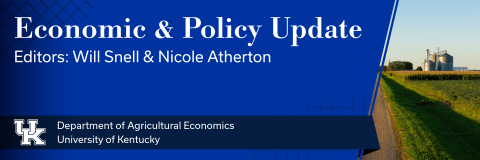Economic & Policy Update E-newsletter
Economic & Policy Update
Affectionately known as the 'bluesheet' due to its history of being printed on blue paper in the 80s, the Economic & Policy Update E-newsletter is a long-standing publication in our department containing articles from our extension faculty and staff on timely, relevant topics from areas including farm management, finance, production, ag policy and trade, etc.
Geared toward a wide range of readers, our diverse team covers commodities ranging from livestock to grain crops and forages to the economics of small fruits and vegetable production in our monthly articles. With a reach far beyond Kentucky, our extension faculty are routinely invited to present at national and international conferences and to state and national government leaders on the same topics covered EPU articles.
Join our subscription list to receive the EPU straight in your inbox at the end of each month and be the first to have access to the most up-to-date information, new program announcements, featured extension resources, and more. Individual articles are also posted to our social media accounts each week following the latest newsletter's release date.

Subscribe to EPU
Subscribers receive new issues straight to their inbox with additional program and news announcements, featured resources, and timely articles from our archive.
Subscribe40+
Years in Publication
1200+
Direct Subscribers
100,000+
People reached annually

Most Recent Newsletter & Articles

July 2025 Newsletter
The newest issue of our monthly extension newsletter, Economic & Policy Update, includes articles covering the farm bill, net farm income, farmers' market prices, bale grazing during droughts, and carbon market terms.
Read Latest NewsletterAll Articles
Browse all of our resources in our library with options to search by topic, category, and author!
Browse
Connect with Us.
Ag Econ Insider E-newsletter
Keep up with recent graduates, student activities & clubs, departmental updates, extension programs, recent awards, and more in one short, easy read through our triannual e-newsletter.
SubscribeEconomic & Policy Update E-newsletter
Each month, extension faculty and staff collaborate on 3-5 short, timely articles in our Economic and Policy Update (EPU) e-newsletter. We also include new program and event announcements.
SubscribeContact Us
We are here to help. If you need assistance, don't hesitate to reach out. Faculty, staff, instructors, and graduate students have contact information available through the "Our People" page or connect with us on our socials.
Contact UsDepartment of Agricultural Economics
400 Charles E. Barnhart Building
Lexington, KY 40546-0276
@UKYAgEcon
